Blog
How to Teach Kids to Sew, and When to Introduce Kids to Quilting
Hi!
I was thinking back this week to some of the fun sewing things we used to do as kids, and that I did with mine when they were little, and I decided to take a look at how to teach kids to sew and quilt in a little more detail. Some of you will have kids or grandkids that will be ready to start teaching sewing, and here’s a few pointers and tips to help.
How to Teach Kids to Sew
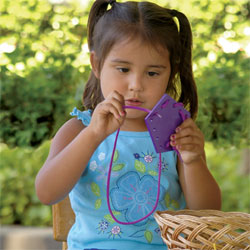
(Image from: https://www.forsmallhands.com/ideas-insights/children-love-to-sew-weave-and-knit )
Have you ever noticed little hands reaching for your fabric stash or curious eyes watching you sew? If so, you might be wondering when the right time is to teach quilting to kids. Sharing your love of quilting with the next generation can be incredibly rewarding—and starting early helps build confidence, creativity, and connection.
So, at what age should kids start quilting? While there’s no strict rule, many children can begin exploring basic sewing and fabric play between the ages of five and eight. At this stage, they’re usually developing the fine motor skills needed for beginner hand sewing or fabric-based crafts.
That said, every child is different, and interest and maturity matter more than age. Some may be ready earlier, while others need more time. If your child shows curiosity about what you’re making or loves organising your threads and scraps, that’s a great sign they might be ready.
If you’re looking for signs your child is ready to start quilting, here are a few things to look for:
- They enjoy crafts and working with their hands
- They can focus for short periods (around 10–15 minutes)
- They can safely use child-friendly scissors or hold a large plastic needle
- They ask questions about your quilting or want to “help” when you’re sewing
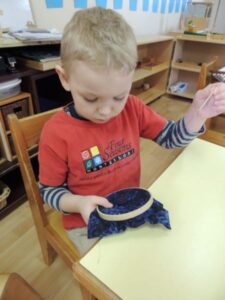
(Image from: https://fourseasonsmontessori.com/2017/11/03/sewing-builds-creativity-focus-and-concentration-in-young-children/)
Once you spot these signs, you can begin with a few simple quilting basics for children. Hand stitching with felt is a great place to start—it’s soft, forgiving, and easy to handle. Sewing on large buttons or making a fabric collage with scraps and glue are also fun, low-pressure ways to introduce the world of fabric and thread. The key is to keep it playful and creative.
Choosing the Right First Project
When thinking about how to teach kids to quilt, choose first projects that are small, manageable, and satisfying to complete.
I remember my mother punching holes in cardboard to make simple shapes that we could sew just with shoelaces – using the hard plastic-tipped ends of the laces instead of needles. We could sew, unthread and sew again as we liked.
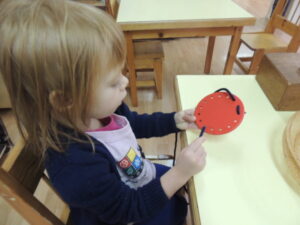
(Image from: https://fourseasonsmontessori.com/2017/11/03/sewing-builds-creativity-focus-and-concentration-in-young-children/)
Remember, children love seeing fast results, so ideas like quilted coasters, fabric bookmarks, or tiny doll quilts are ideal. Let them choose their own fabrics and colours—even if the combinations are wild! This helps build ownership and excitement.
When my daughter was little, we had a lot of fun with applique to start. I ironed fusible webbing to the back of several bright fabric scraps, then she cut out shapes and arranged little pictures on a plain white background, and we ironed them to make it permanent. She loved the creativity of doing this, and we even turned a few into simple tote bags or zippered pouches that she could use.
Safety is also a top priority when teaching quilting for kids. Whilst it’s best to use child-safe tools such as blunt-tip scissors and large, easy-to-thread needles if they’re sewing with minimal supervision, but don’t be afraid to bring out ‘proper’ equipment and show them how to use it properly too, as long as you’re there to supervise and work with them, and can explain clear rules for safe use.
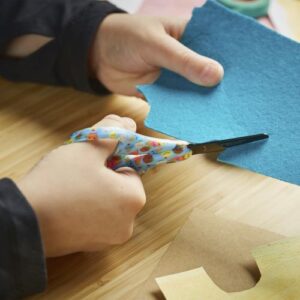
(Image from: https://www.walmart.com/ip/Fiskars-Designer-Non-stick-Blunt-tip-Kids-Scissors-5-in-Kawaii-Ice-Cream/362973340)
Avoid pins at first and supervise closely if you bring out the iron or sewing machine later on. Creating a dedicated sewing kit just for them—with colourful thread, fun fabric pieces, and safe tools—can make them feel extra special.
Of course, not everything has to go perfectly. In fact, it shouldn’t. Learning to quilt is as much about exploration as it is about sewing.
Encourage wonky stitches, uneven seams, and creative flair. Praise effort over results and make sure your quilting sessions are full of fun and encouragement—not correction. This is especially important if you’re hoping to pass on your love of quilting as a joyful lifelong skill.
Bonding through Quilting
One of the loveliest parts of sewing and quilting with children is the connection it creates. Sitting together to sew opens the door for quiet conversations and storytelling. Many parents and grandparents find that quilting becomes a treasured shared activity—a beautiful way for special time together and creating connection between different generations.
When to Introduce the Sewing Machine
If you’re wondering when to teach a child to use a sewing machine, most kids can begin experimenting around ages nine to twelve, depending on their coordination and confidence. Start slow, with supervised practice stitching straight lines on scrap fabric. If your machine has a speed setting, keep it low at first, and focus on building comfort and familiarity.
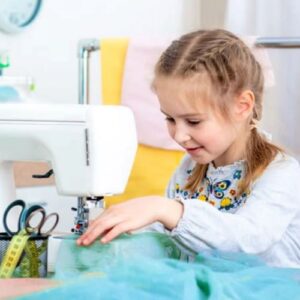
(Image from: https://sewmeschool.com.au/products/kids-4-week-mini-term?variant=41667237544136)
There are some wonderful beginner-friendly resources available if you’d like a little extra help. Look for quilting books written for children, YouTube tutorials on beginner sewing for kids, or starter kits that include everything needed for a first project. These can take the pressure off and add some structure to your early quilting sessions.
There are many benefits to teaching quilting at a young age. It helps children develop patience, strengthens hand-eye coordination, and gives them the satisfaction of seeing a project through from start to finish. Best of all, it boosts confidence. There’s something so special about watching a child hold up their creation and say, “I made this!”
Ready to Get Started?
If you’ve been waiting for the “right time” to teach your child or grandchild how to sew or quilt, now might be just the moment.
Whether you’re introducing your kids or grandkids to sewing, remember this: it’s all about connection, creativity, and fun. Start where they are, follow their interests, and celebrate every stitch along the way.
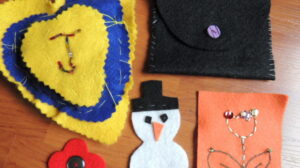
Have you tried quilting with your kids or grandkids? I’d love to hear how it went! Share your favourite starter projects or tips in the comments.

